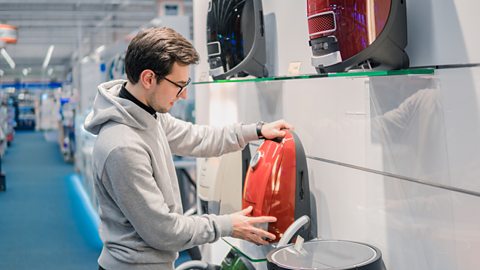Core content
New and emerging technologies - Edexcel
Companies are trying to save money, improve products, develop new materials and become more efficient. New technologies are developed to positively impact the manufacturing industry and society.

Energy generation and storage - Edexcel
Energy generation and storage have a huge global impact on our lives - from decisions about the use of fossil fuels and their effect on our environment, to the development of cleaner, more-modern ways to create and store energy.

Developments in modern materials - Edexcel
Developments in science and engineering lead to changes in materials technology. There are a range of modern materials with impressive properties, as well as traditional ones such as wood or metal.

Electronic systems - Edexcel
Electronic systems can be understood using a systems block approach of input, process and output. This is vital in designing systems to understand how devices are programmed and how they operate.

Mechanical devices - Edexcel
Mechanical devices can change one form of force to another. All moving parts work on some sort of mechanism.

Material categories and properties - Edexcel
All materials have physical and working properties. Physical properties are the traits a material has before it is used, whereas working properties are how the material behaves when it is manipulated.

Design contexts - Edexcel
Designers need to ensure their designs are fit for purpose. Making informed material and manufacturing decisions can help ensure materials are conserved and the impact on the environment is reduced.

Environmental, social and economic challenges - Edexcel
When a product is developed, consideration should be given to social, economic and environmental issues, such as the materials used, the product life cycle and how it will be recycled or disposed of.

Investigating past work - Edexcel
Learning from and evaluating other designs to identify features that could be improved, eg changing materials, can help make a new design more successful or appealing to its target audience.

Design strategies - Edexcel
Designers use iterative design to simulate the design methods used in industry. Designers continually test, evaluate and refine ideas using a variety of methods to ensure designs meet user needs.

Communication of ideas - Edexcel
There are a variety of techniques, materials and media that designers can utilise while developing their ideas. Each provides a different function and allows designers to communicate ideas effectively.

Materials
Papers and boards - Edexcel
Paper is made from wood pulp or recycled material. It may be used in packaging, drawing and sketching, or model making.

Timbers - Edexcel
Hardwood and softwood are types of timber that come from many different trees. Manufactured boards such as MDF and plywood are man-made.

Metals - Edexcel
Metals come from an ore that is mined from the ground. Metals can be used for all methods of production, from bespoke pieces of jewellery to mass-produced cars.

Polymers - Edexcel
Most polymers are manufactured and are designed by chemical engineers. Most are made using non-renewable crude oil. Difficulties around disposal mean there is a drive to reduce the use of plastics.

Textiles - Edexcel
Textiles are made from fibres, classified as either natural or manufactured. Fibres are twisted into yarns before being made into woven, knitted or bonded fabrics.

Systems - Edexcel
Components are chosen based on factors including working properties, environmental impact, function, manufacturing processes etc. It is important to choose a component fit for purpose.

NEA project skills
Investigating - Edexcel
During the designing and making processes it is important to gather feedback from the client and users. Refining the product based on this feedback helps solve any problems before production begins.

Designing - Edexcel
Designers use many techniques to create products and solve problems. Design and development involve creating working drawings and parts lists to enable a third party to manufacture the design.

Making - Edexcel
Manufacturers need to consider the form, function and cost of designs before production. Designers need to consider safety, availability of materials and minimising waste, while maintaining quality.

Evaluating - Edexcel
Evaluating ideas, models and feedback is an ongoing process, utilised in continuing to adapt and improve products to make them more useful, appealing and profitable.

Links
- External linkExternal link
- External linkExternal link
- External linkExternal link
- External linkExternal link
- External linkExternal link
- SubscriptionSubscription